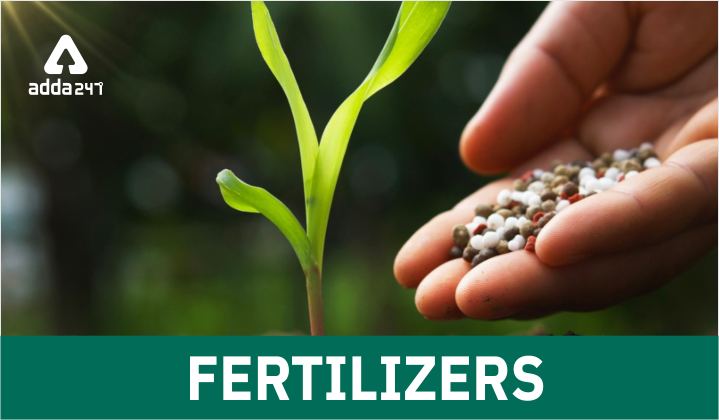Any natural or manufactured item that is applied to soil or plant tissues to offer plant nutrients is known as a fertilizer. Liming materials and other non-nutrient soil additives are not necessarily fertilizers. Fertilizer comes in a variety of forms, both natural and man-made. Fertilization in most current agricultural practices concentrates on three basic macro nutrients: nitrogen (N), phosphorus (P), and potassium (K), with micro nutrient supplements such as rock dust added on occasion. Farmers use a range of methods to apply these fertilizers, including dry, pelletized, and liquid application processes, as well as heavy agricultural equipment and hand-tool approaches.
Types of Fertilizers
Fertilizers are categorised as straight fertilizers if they only offer a single nutrient (such as K, P, or N). Multi nutrient fertilizers also known as Complex fertilizers, include two or more nutrients, such as nitrogen and phosphorus. Fertilizers are also classed as inorganic versus organic (which is the focus of this article). Except for urea, inorganic fertilizers do not contain carbon-containing compounds. Organic fertilizers are often made up of (recycled) plant or animal debris. Because different chemical treatments are necessary for their synthesis, inorganic fertilizers are sometimes known as synthetic fertilizers.
1. Single nutrient fertilizers:
- Ammonia or its solutions are the most used nitrogen-based direct fertilizers. Also extensively used is ammonium nitrate (NH4NO3). Urea is a preferred nitrogen source because, unlike ammonia and ammonium nitrate, it is solid and non-explosive. Calcium ammonium nitrate (Ca(NO3)2 NH4.10 H2O) has just a small share of the nitrogen fertilizer market.
- Superphosphates are the most common straight phosphate fertilizers. SSP (single superphosphate) is made up of 14–18 percent P2O5 in the form of Ca(H2PO4)2, as well as phosphogypsum (CaSO4.2 H2O). TSP is normally made up of 44–48 percent P2O5 and no gypsum. Double superphosphate is a compound made composed of single and triple superphosphate. A typical superphosphate fertilizer is water soluble to the tune of 90%.
- Muriate of potash (MOP) is the most common potassium-based straight fertilizer. Muriate of potash is commonly sold as a 0-0-60 or 0-0-62 fertilizer and contains 95–99 percent KCl.
2. Multi nutrient fertilizers
These fertilizers are widely used. They are made up of two or more nutrients. There are two types of fertilizers in this category: binary and multi nutrient:
- Plants receive both nitrogen and phosphorus from major two-component fertilizers. NP fertilizers are what they’re called. Monoammonium phosphate (MAP) and diammonium phosphate (DAP) are the most used NP fertilizers (DAP). NH4H2PO4 is the active component in MAP. (NH4)2HPO4 is the active component in DAP. Water solubility is about 85% for MAP and DAP fertilisers.
- NPK fertilisers are made up of three parts: nitrogen, phosphorus, and potassium. NPK fertilisers are divided into two categories: compound and mixes. Blended NPK fertilisers are physical combinations of single nutritional components, whereas compound NPK fertilisers contain chemically bound constituents.
Uses Of Fertilizers
Following are the major uses of Fertilizers:
- Fertilizers are routinely used to grow all crops, with treatment rates varying based on the soil fertility, which is normally determined by a soil test, and the crop in question. Legumes, for example, fix nitrogen from the air and do not require nitrogen fertiliser in most cases.
- Solid and liquid fertilizers are used to fertilize crops. Approximately 90% of fertilizers are used as solids. Urea, diammonium phosphate, and potassium chloride are the most often used solid inorganic fertilizers. Granulated or powdered solid fertiliser is the most common type.
- Solids are frequently present as prills, or solid globules. Anhydrous ammonia, aqueous ammonia solutions, aqueous ammonium nitrate solutions, and urea are examples of liquid fertilisers. To make a concentrated liquid fertiliser, dilute these concentrated materials with water. Liquid fertiliser has the advantage of having a faster effect and being easier to apply.
- Urea is extremely water soluble, making it ideal for use in fertiliser solutions (in conjunction with ammonium nitrate: UAN), such as foliar feed fertilisers. Granules are chosen over prills for fertiliser application because of their narrower particle size dispersion, which is advantageous for mechanical application.
- Foliar fertilisers are applied to the leaves directly. This method is nearly always used to apply water-soluble straight nitrogen fertilisers, and it is particularly effective for high-value crops like fruits. The most frequent foliar fertiliser is urea.
Importance of Fertilizers
Fertilizers are essential for revitalising the soil by giving the nutrients that plants require to thrive. The macronutrients nitrogen, phosphorus, potassium, calcium, sulphur, magnesium, oxygen, hydrogen, and carbon, as well as the micronutrients iron, boron, chlorine, manganese, zinc, copper, molybdenum, and nickel, are all found in nature. The nutrients follow the crop when it is harvested. As a result, important nutrients are taken from the soil. When the soil is unable to replenish all of the nutrients on its own, fertilizers are used to supplement the ones that are deficient. Higher crop yields are required to keep up with the world’s growing population. To restore the soil, both organic and mineral fertilizers can be employed. Organic fertilizers have a lower nutritional content than mineral fertilizers, which are concentrated and have a tightly controlled nutrient content.
All of the nutrients found in various fertilizers can be found in nature. Nitrogen, potassium, and phosphate are the most prevalent nutrient sources in mineral fertilizers. Air is the source of nitrogen. Ammonia is made from a mixture of nitrogen from the air and hydrogen from natural gas in the most typical nitrogen fertilizer manufacturing process. Although air contains 78 percent nitrogen, plants cannot obtain the nitrogen they require straight from the air; instead, they must obtain it from the soil through their roots. Potassium comes from ancient sea and lake deposits that date back millions of years. Potassium fertilisers are made from potassium chloride, which is found in nature. This is sodium chloride, which is similar to table salt. The name ‘potash’ comes from the high potassium content of ash from burning wood or straw. Plant roots cannot naturally reach potassium sources since they are often located far below the soil surface (1-2 km depth).
FAQs
Ques. What are the 3 types of fertilizers?
Ans. Fertilizers are categorised as straight fertilizers if they only offer a single nutrient (such as K, P, or N). Multi nutrient fertilizers also known as Complex fertilizers, include two or more nutrients, such as nitrogen and phosphorus. The Big 3 primary nutrients in commercial fertilizers are nitrogen, phosphorus, and potassium, or NPK. Each of these essential elements is important for plant nutrition.
Ques. What is fertilizer and example?
Ans. Any natural or manufactured item that is applied to soil or plant tissues to offer plant nutrients is known as a fertilizer. Liming materials and other non-nutrient soil additives are not necessarily fertilizers. Manure, slurry, worm castings, peat, seaweed, and guano are examples of naturally occurring organic fertilizers. Green manure crops are also planted to supplement soil nutrients.
Ques. What are fertilizers in short answer?
Ans. Any natural or manufactured item that is applied to soil or plant tissues to offer plant nutrients is known as a fertilizer. Fertilizers are chemical substances that farmers use on a regular basis to help their crops grow and produce more. Fertilizers supply essential nutrients for plant growth.
Ques. What are the 2 types of fertilizer?
Ans. Fertilizers are also classed as inorganic versus organic (which is the focus of this article). Except for urea, inorganic fertilizers do not contain carbon-containing compounds. Inorganic and organic fertilizers are the two types of fertilizers. In the broadest sense, fertilizers are any living or inorganic substance that aids in plant growth and health.
Ques. is the most common type of fertilizer?
Ans. Urea and 16-20-0 are the most often used fertilizer grades. Urea is largely used as a nitrogen source, whereas 16-20-0 is primarily used as a phosphorus source. Instead of 16-20-0, 18-46-0 and, less typically, 14-14-14 are used in some locations. Potassium isn’t usually considered a limiting nutrient.




 Who Is Delcy Rodriguez? Venezuela’s Inte...
Who Is Delcy Rodriguez? Venezuela’s Inte...
 US Move on Venezuela's Oil: What It Mean...
US Move on Venezuela's Oil: What It Mean...
 US Military Action in Venezuela: Why Was...
US Military Action in Venezuela: Why Was...







